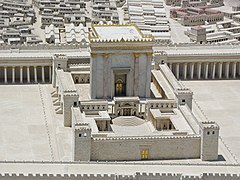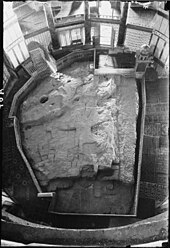Dome of the Rock
The Dome of the Rock (Arabic: قبة الصخرة, romanized: Qubbat aṣ-Ṣaḵra) is an Islamic shrine at the center of the Al-Aqsa mosque compound on the Temple Mount in the Old City of Jerusalem.
[1][2] Its initial construction was undertaken by the Umayyad Caliphate on the orders of Abd al-Malik during the Second Fitna in 691–692 CE, and it has since been situated on top of the site of the Second Jewish Temple (built in c. 516 BCE to replace the destroyed Solomon's Temple and rebuilt by Herod the Great), which was destroyed by the Romans in 70 CE.
The octagonal plan of the structure may have been influenced by the Byzantine-era Church of the Seat of Mary (also known as Kathisma in Greek and al-Qadismu in Arabic), which was built between 451 and 458 on the road between Jerusalem and Bethlehem.
[3] The Foundation Stone (or Noble Rock) that the temple was built over bears great significance in the Abrahamic religions as the place where God created the world as well as the first human, Adam.
The site's great significance for Muslims derives from traditions connecting it to the creation of the world and the belief that the Night Journey of Muhammad began from the rock at the centre of the structure.
[7][8] Designated by UNESCO as a World Heritage Site, it has been called "Jerusalem's most recognizable landmark"[9] along with two nearby Old City structures: the Western Wall and the "Resurrection Rotunda" in the Church of the Holy Sepulchre.
It is capped at its centre by a dome, approximately 20 m (66 ft) in diameter, mounted on an elevated circular drum standing on 16 supports (4 tiers and 12 columns).
[14] The inner circular row of drum supports and the octagonal arcade create an inner ambulatorium that encircles the holy rock.
[16] Surah Ya-Sin (the 'Heart of the Quran') is inscribed across the top of the tile work and was commissioned in the 16th century by Suleiman the Magnificent.
The date is recorded as AH 72 (691/2 CE), the year most historians believe the construction of the original Dome was completed.
[11][37] The historian Shelomo Dov Goitein has argued that the Dome of the Rock was intended to compete with the many fine buildings of worship of other religions: "The very form of a rotunda, given to the Qubbat as-Sakhra, although it was foreign to Islam, was destined to rival the many Christian domes"[38] - and more specifically, the Church of the Holy Sepulchre, according to others.
[43] The Crusaders captured Jerusalem in 1099 and the Dome of the Rock was given to the Augustinians, who turned it into a church, while the nearby Al-Aqsa main prayer hall or Qibli Mosque first became a royal palace for a while, and then for much of the 12th century the headquarters of the Knights Templar.
[clarification needed] The Templum Domini, as they called the Dome of the Rock, featured on the official seals of the Order's Grand Masters (such as Everard des Barres and Renaud de Vichiers), and soon became the architectural model for round Templar churches across Europe.
Saladin's nephew al-Malik al-Mu'azzam Isa carried out other restorations within the building, and added the porch to the Jami'a Al-Aqsa.
[54] In another major restoration project undertaken in 1874–1875 during the reign of the Ottoman Sultan Abdülaziz, all the tiles on the west and southwest walls of the octagonal part of the building were removed and replaced by copies that had been made in Turkey.
[55][56] Haj Amin al-Husseini, appointed Grand Mufti by the British in 1917, along with Yaqub al-Ghusayn, implemented the restoration of the Dome of the Rock and the Jami Al-Aqsa in Jerusalem.
Parts of the Dome of the Rock collapsed during the 11 July 1927 earthquake, and the walls were left badly cracked,[57] damaging many of the repairs that had taken place over previous years.
The work included replacement of large numbers of tiles dating back to the reign of Suleiman the Magnificent, which had become dislodged by heavy rain.
In 1965, as part of this restoration, the dome was covered with a durable aluminium bronze alloy made in Italy that replaced the lead exterior.
[58] In 1993, the golden dome covering was refurbished following a donation of US$8.25 million by King Hussein of Jordan, who sold one of his houses in London to fund the 80 kilograms (180 lb) of gold required.
Some Orthodox rabbis encourage Jews to visit the site, while most forbid entry to the compound lest there be a violation of Jewish law.
[63] The location of the Dome of the Rock is believed by many Muslims to be the site mentioned in Sura 17 of the Qur'an, which tells the story of the Isra and Mi'raj, the mythical Night Journey of Muhammad from the Great Mosque of Mecca to the Masjid Al-Aqsa ("the farthest place of prayer") where he prayed, and then to visit heaven where he leads prayers and rises to heaven to receive instructions from Allah.
[64] Judging though by the early Muslim sources, this does not seem to have been yet a fully formulated part of the beliefs shared by Muslims during the construction of the Dome in the 8th century, and the inscriptions inside the dome attributing the building to Caliph 'Abd al-Malik in the year 691/2 do not refer at all to the Night Journey, but contain only the Quranic view on the nature of the prophet Isa (Jesus) instead.
when He determines a matter, He only says to it, "Be", and it is.According to Goitein, the inscriptions decorating the interior clearly display a spirit of polemic against Christianity, whilst stressing at the same time the Qur'anic doctrine that Jesus was a true prophet.
The formula la sharika lahu ('God has no companion') is repeated five times; the verses from Sura Maryam 19:35–37, which strongly reaffirm Jesus' prophethood to God, are quoted together with the prayer: Allahumma salli ala rasulika wa'abdika 'Isa bin Maryam – "O Lord, send your blessings to your Prophet and Servant Jesus son of Mary."
[38] At the beginning of the 8th century, Ibn Ishaq codified the earliest Arabic source pertaining to the Jerusalem Rock, as part of his Sirat al-Nabi, a biography of the Islamic prophet Muhammad, introducing the notion that right after his Night Journey from Mecca to Jerusalem (isra'), he set off immediately and specifically from the Rock in his Ascension (mi'raj) to Heaven, where God instructed him in the doctrines of the new religion.
[66] Other Islamic scholars believe that Muhammad ascended to Heaven from the Masjid Al-Aqsa, of which the Dome of the Rock is a part.
[weasel words] Some religious Jews, following rabbinic teaching, believe that the Temple should only be rebuilt in the messianic era, and that it would be presumptuous of people to force God's hand.
[72] Jeremy Gimpel, a US-born candidate for The Jewish Home political party in the 2013 Israeli elections, caused a controversy when he was recorded telling a Fellowship Church evangelical group in Florida in 2011 to imagine the incredible experience that would follow were the Dome to be destroyed and the construction of the Third Temple begun.








